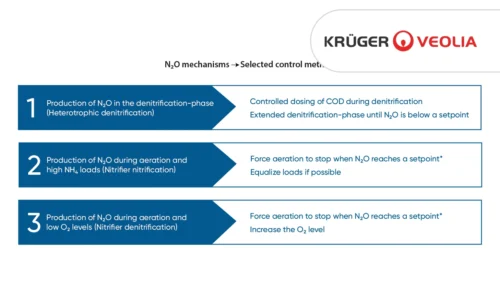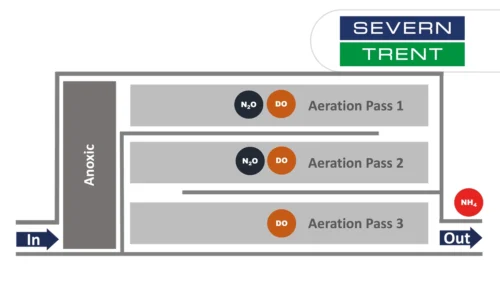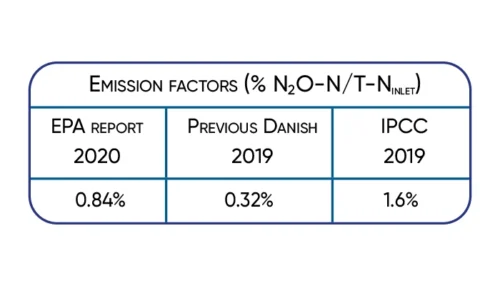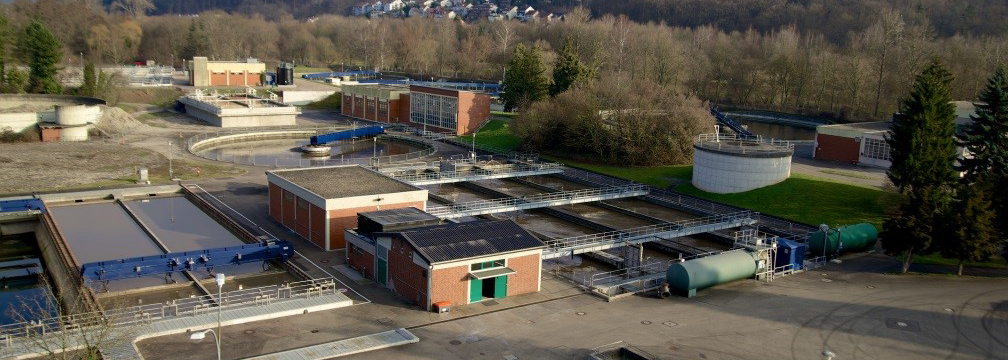Addition of External Carbon
The composition of the wastewater in Pforzheim is strongly influenced by high nitrate loads coming from the discharge of several companies for metal recycling. The nitrate loads vary considerably both during the day and over the week.
In order to ensure keeping within the prescribed nitrogen limits for the effluent, a discontinuous addition of external carbon source in the upstream denitrification zone and, if necessary, even in the downstream denitrification zone is mandatory in Pforzheim.
By adding of a carbon source for the biological carbon and nitrogen removal, the formation and emission of CO2 and also nitrous oxide (the most relevant greenhouse gases that are released in the biological wastewater treatment) increase significantly, as carbon sources substrates with the active substance of acetate, glycol, glycerol are dosed in Pforzheim. In addition, sludge water (supernatant water from the thickening of primary sludge) is used as a carbon source daily.

Research Project to Reduce Emissions
In the course of climate change and the holistic view of emissions from wastewater treatment plants, the optimization and exploration of nitrous oxide formation is in a research project:
NoNitriNox
Planning and operation of resource and energy efficient wastewater treatment with targeted prevention of environmentally hazardous emissions - funded by the BMBF (Funded program: "Intelligent and multifunctional infrastructure systems for a sustainable water supply and sanitation (INIS) ") in focus. The project participants are Ing. Büro IFAK, University of Stuttgart, Weber Ingenieure, WWTP Pforzheim WWTP Steinlach Wiesaz.
To determine the formation rate of nitrous oxide in the denitrification and the nitrification zone, an N2O sensor from Unisense Environment A/S is used.

N2O Formation Favored in the Denitrification
As this article was written, the N2O Wastewater System has been in use for over one year for the detection of nitrous oxide concentrations in the dissolved phase in Pforzheim.
It has been proven by means of the measurement that the nitrous oxide formation is actually favored in the denitrification by the addition of the carbon source or by the addition of the sludge water. Since it works equipped with the N2O Wastewater Controller with calibration and evaluation on board, the handling has become much simpler and user-friendly. The use of the external evaluation devices is thus no longer required.
All relevant measurements in Pforzheim to assess the nitrous oxide formation are integrated in the process control system (PLC) and are available as 15-minute values.

N2O Measurements as Basis for Optimization
According to the insight from the nitrous oxide measurements at the WWTP Pforzheim an optimization of the sludge water dosing can be made already. At present, the addition of the sludge water occurs unregulated (compared to the controlled addition of the carbon source) and caused fairly high N2O formation.
Furthermore, the N2O Wastewater Controller from Unisense Environment is used to create the process profiles (N2O formation in the aqueous phase) in the nitrification tank.
Publication of the results is carried out within the framework of the research project NoNitriNox. Learn more at www.ifak.eu.

Tech Notes & References

Two liquid phase N2O sensors accurately represent process dynamics and emissions in most common raceway and recirculation reactors.

Learn how Kerteminde Forsyning applied nitrous oxide data to reduce the formation of N2O while maintaining low nitrogen emissions

Case Study: Full-scale comparison of N2O emissions determined by liquid sensors and off-gas measurement

Significant 3-fold increase in IPCC2019 wastewater N2O emission factor supported by Danish studies.

A case study from Kralingseveer WWTP in the Netherlands explores the influence of sensor placement.

Based on data from Danish WWTPs through advanced online-control.

Learn about the results from N2O monitoring in the activated sludge tanks at Severn Trent’s Spernal sewage treatment plant

Monitor the N2O concentration in the liquid and use N2O as a control parameter for carbon dosage in the denitrification process.

Learn how the water utility Aquafin controls emissions from deammonification processes using the the N2O Wastewater Sensor

Greenhouse gas emissions at wastewater treatment plants are coming into focus as the water industry works to reduce its climate footprint

The investment costs had initially deterred us somewhat. However ...

A study of three very different WWTPs in Denmark: Bjergmarken (125,000 PE), Holbæk (60,000 PE), and Hvalsø (11,570 PE)

The available data show that the nitrous oxide emission varies in time and between wastewater treatment plants.

Information regarding N2O emissions from trickling filters is limited, partly caused by the difficulties in capturing off-gases.

Significant 3-fold increase in IPCC2019 wastewater N2O emission factor supported by Danish studies.


